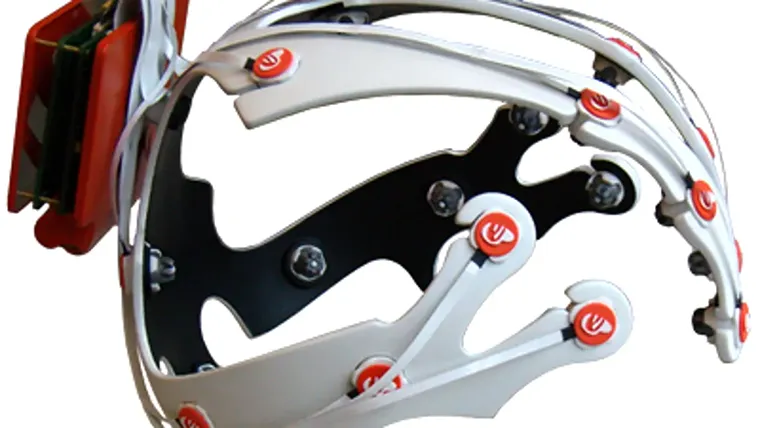Brain-Computer Interfaces for Manipulating Dreams
A first-generation commercial brain-computer interface (BCI) is being released by Emotiv Systems later this year. What does the future hold for BCI?

By 2050, and likely sooner, you will be able to buy a BCI device that records all your dreams in their entirety. This will be done in one of two ways. One method would be to use distributed nanobots less than a micrometer in diameter to spread throughout the brain and monitor the activation patterns of neurons.
By this point, cognitive science will have advanced enough to know which neural activation patterns correspond to which sensory experiences. This has already been done with cats (using electrodes, not nanobots), where researchers led by scientist Garrett Stanley were able to extrapolate what a cat was seeing merely by monitoring the neurons of its visual cortex. Here are some images they obtained:

The next steps will be to increase the resolution, add monitoring of emotions, sounds, and smells, and make it safe for human use. An alternative route, if nanobots are still not ready for commercial deployment by 2050, is to have minimally invasive surgery where tiny holes, no larger than a grain of sand, are drilled in the skull. (Small price to pay, I’d say. And if drilling holes in the skull, even holes too small to do any damage, bothers you, then wait for the nanobots.)
Electronic nanofibers could be routed through these holes from a port on the outside to neurons throughout the brain. The holes could be protected by a plastic membrane, ensuring that no foreign particles could pass through them into the brain. The access ports on the scalp would be compatible with a BCI headset designed to monitor activity in specific neural groups and selectively stimulate neurons according to a program.
A major challenge, of course, would be to get FDA approval for such a device. The therapeutic and practical benefits of a high-resolution BCI device are so large that if it can be shown not to cause any damage or negative side effects to its user, approval seems likely.
If the BCI device offers input to the brain as well as recording output, then dreams could be played back too. A Dream Machine would let us show our dreams to others. If we know which neural activation pattern corresponds to which perceptions (sight, sounds, etc.), it’s not a huge leap to selectively stimulate neurons to produce customized dream scenarios, or even enter the dreams of others in action. (In ascending order of technological difficulty.)
Manipulating our dreams… how many thousands of years has humanity waited for this? Here’s a frequent kind of background I see in my dreams:

…other things I see include gigantic academic complexes, cliff networks, green hills overlooking sunny blue bays, and many others. I’m sure you can imagine hundreds of scenarios from your dreams, many of which seem so fleeting. But it won’t necessarily be that way forever.
The possible societal effects of a Dream Machine would be immense. Dream recordings and recreations would offer an opportunity to:
Validate or refute Freudian theories about the connections of dreams to subconscious or conscious psychological states.
Create a “science of dreams” or oneirology, that organizes all available dream data, breaks up dreams into categories, studies which type of people get which dreams, etc.
Create a “dream entertainment industry” where people choose to have customized dreams, with features like greater visual complexity or richness of colors, or even massively multiplayer dreams.
The possible rise of “dream celebrities” — people who freely upload their dreams for others to examine, followed by a positive reception. People might lead double lives — boring accountant by day, world-famous lucid dreamer by night. Some people might even get paid for their dreams.
Uncover the hidden world of dreams that barely rise above our subconscious. People tend to have several dreams per night, but remember only one or two. We experience these dreams when they happen, our brain just neglects to transfer the information content into long-term memory. (The reasons for this are likely evolutionary — we would get confused about reality if we remembered too many of our dreams.) Imagine if we could record all these dreams and play them back at will. With enough storage density (molecular memory), you could even store your dreams on a pendant around your neck.
Convert dream-worlds into real-worlds; amusement parks based on dreams, or utility fog banks that quickly morph in response to a given personal or collective dreamscape. Or vice versa: turn real world places and people into dream objects.
In general, blur the line between dreams and reality by making dreams more tangible, manipulable, interactive, customizable, and social. Bring dreams “in from the cold”. Make dreams as mysterious, colorful, productive, foreign, erotic, or mundane as you want them to be.
Considering these possibilities, the first thing that makes me nervous is that people would institute inappropriate regulations over the use of this technology. For instance, some groups of people might hate the idea of removing some of the “mystery of dreams” (like how modern biology ostensibly dispels some of the mystery of life, or modern physics dispels some of the mystery of nature) through technology. As someone who is socially liberal, barring sufficiently negative externalities, I’d advocate light regulation on this technology. Heavy regulation should be saved for more dangerous technologies such as synthetic biology and molecular nanotechnology.
Possible risks:
-
If dreams start to be run on servers, hacking or computer viruses could be a problem. In most cases, this would likely just result in the dream shutting down (not a big deal — this already happens all the time), but if your dream got hijacked, someone could use them to threaten or attempt to brainwash you. This is what doubters will focus on excessively — but remember, our brain and body is already accessible to “viruses” — including real viruses, bacteria, prions, and parasites, but we manage to defend against them.
Eventually, we will develop computers with technological immune systems as complex and effective as the human immune system, it will just take time. Even if dream-recording BCI devices are possible, dream-manipulating BCI devices may have to wait until computer security catches up.
Communication through dreams could make it more difficult for parents to control their children, or for regimes to control their populations, by opening up the information channels they have access to. In this regard, the challenge would be similar to a magnified version of the struggles already seen with the Internet in general.
A “delightful dream” so thoroughly enjoyable and amazing that it spreads across the world, and all humanity is consumed by it. From that point onward, we only develop our civilization for the purpose of maintaining this euphoric state, a local maxima in the fitness landscape of cultural progress and evolution. This might be a dream that involves direct stimulation of the pleasure center. (For this reason, it might be good to avoid building BCI devices that directly stimulate the pleasure center.)
The “delightful dream” scenario would be considered a subset of wireheading. It might be more notorious, though, because while many people wouldn’t stick electrodes into their head just to stimulate their pleasure center, they might be willing to use a Dream Machine, which could get them trapped in a wirehead addiction when they otherwise would avoid it.
Those are the main risks I can think of, but there are likely more. One thing is for sure — if we can avoid the risks and maximize the benefits, the world will be a very interesting place in 2050.
Sweet dreams!
